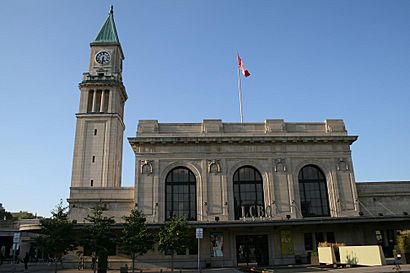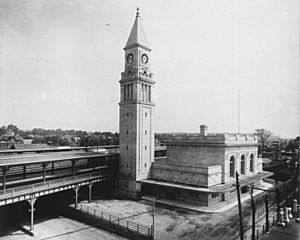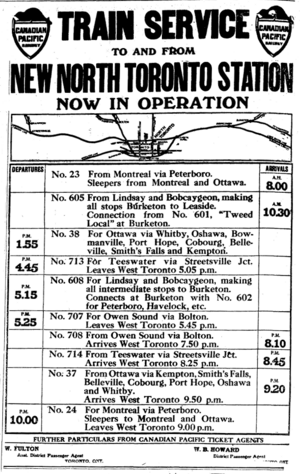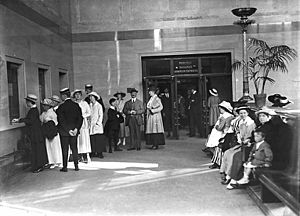North Toronto station facts for kids
Quick facts for kids
North Toronto Station
|
|
|---|---|
 |
|
| Location | 10 Scrivener Square Toronto, Ontario Canada |
| Coordinates | 43°40′51″N 79°23′26″W / 43.68083°N 79.39056°W |
| Owned by | Liquor Control Board of Ontario |
| Platforms | None |
| Tracks | 2 |
| Construction | |
| Architect | Darling and Pearson |
| Architectural style | Beaux Arts |
| History | |
| Opened | 1916 |
| Closed | 1931 |
| Official name: C.P.R. North Toronto Station | |
| Designated: | 1976 |
The North Toronto railway station is a beautiful old building in Toronto, Ontario, Canada. It used to be a busy train station for the Canadian Pacific Railway (CPR). You can find it in the northwest part of the Rosedale neighbourhood, close to Yonge Street and the Summerhill area. Today, this historic building is home to a large store called the Liquor Control Board of Ontario (LCBO), which sells drinks for adults.
Contents
Station Design and Look
The North Toronto Station was built in a fancy style called Beaux Arts. This style often features grand, impressive buildings. The station has a tall clock tower that reaches 43 metres (140 feet) high. This tower was designed to look like the famous Campanile di San Marco bell tower in Venice, Italy.
Inside the main part of the station, there's a large hall with a very high ceiling, about 11.6 metres (38 feet) tall. The walls are covered in shiny marble, and elegant bronze lights hang from the ceiling. The station was built using a special kind of stone called Tyndall limestone from Manitoba. This stone is known for being strong against bad weather and for having cool fossil patterns in it. The four clock faces on the tower are each 2.4 metres (8 feet) wide and were always lit up at night when the station was in use.
A Look Back: Station History
The North Toronto Station was designed by a company called Darling and Pearson. It was built in 1916 to serve the Canadian Pacific Railway line that ran through Toronto. The first stone was placed on September 9, 1915, by the city's mayor, Tommy Church. The station officially opened for passengers on June 14, 1916, and cost about $750,000 at that time.
This new, grand station replaced an older, smaller one nearby. For a while, both stations stood together. The North Toronto Station was quite important; for example, Canada's first shipment of whale meat passed through it around 1917.
However, when the much larger Union Station opened in 1927, and the Great Depression (a time of economic hardship) began soon after, the North Toronto Station became less busy. It had been meant to help the bigger station, but it started to struggle. The last regular passengers used the station on September 27, 1930. After that, a store called Brewers' Retail moved into part of the building in 1931.
The station had a special moment on May 22, 1939. King George VI and Queen Elizabeth (who was the mother of Queen Elizabeth II) arrived there for their first visit to Toronto. This was the first time a reigning British monarch had visited Canada. After their visit, the royal couple left Toronto from Union Station. After World War II, some soldiers returning home also passed through the station, making them its last train passengers.
On September 9, 1915, a time capsule was placed inside the station's cornerstone. A time capsule is like a container filled with items from a certain time, meant to be opened much later. This capsule weighed about 1.7 tonnes (3,700 pounds)! It was found and opened 100 years later, in September 2015. Inside, there were about 50 items, including blueprints, an old map of Toronto, newspapers from 1915, coins, and a city handbook. The items were in great condition! A new time capsule was then buried in the same spot. It included items from 2015, like current newspapers, magazines, a BlackBerry, an iPhone, a modern map of Toronto, and some bottles of special drinks, as a nod to the building's current use as a store.
Station Restoration
Over the years, parts of the station's beautiful inside were hidden behind walls put up by the stores that moved in, like Brewers' Retail and later the Liquor Control Board of Ontario (LCBO). But in 2004, the building was carefully restored to its original beauty. Architects Goldsmith Borgal & Company Ltd. and Eastern Construction worked on this project.
The clocks had been taken off the tower between 1948 and 1950, which meant birds could get inside! One of the first jobs during the restoration was to remove about 4,000 kg (8,800 pounds) of dried bird droppings from the tower's base. The original clock parts were mostly found and fixed. Now, with the help of GPS signals, the clocks show the time very accurately.
The building is protected by the Ontario Heritage Act since 1976, which means it's an important historical site. It also has a Heritage Easement, further protecting its special features. The City of Toronto also considers it part of a "Heritage Conservation District."
Even though it's now the largest LCBO store in Canada, freight trains still run on the tracks behind the station. During the restoration, special rubber from old car tires was added to the concrete floor. This helps stop train vibrations from shaking bottles inside the store!
Outside the station, there's a public space called Scrivener Square, named after Margaret Scrivener. It has a cool water fountain and is a nice place for people to gather.
Future Ideas for the Station
People have suggested that the North Toronto Station could be used for trains again in the future. In the 1980s, GO Transit thought about using it for a "Midtown" train line to help commuters travel across the city without going through the busy downtown area. More recently, in 2007, a new transit plan included a similar idea for a "Midtown corridor." Some people also think the station could be used for Via Rail or Ontario Northland trains to help ease crowding at Union Station, or even as part of a future train link to the airport.
Station Features and Materials
The original station building was quite large. The main waiting area inside has a very high ceiling, about 38 feet tall, making it feel grand. The building's design uses a lot of similar colours, mostly beige. This comes from the Tyndall limestone on the outside and the beige, brown, and green marble and light brown terrazzo floors inside. These materials give the building a solid, strong look. If you look closely at the limestone, you can even see fossils!
The station is designed with a lot of "threes." For example, the main building has three parts, and there are three large arched windows at the front. The clock tower also follows this pattern, with three main sections that get lighter as they go higher. The bottom part is heavy stone, the middle has more open spaces with columns, and the top is narrower with a steep roof. This design was inspired by the famous Campanile of St. Mark's in Venice.




